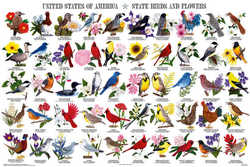
North Carolina Symbols
North Carolina State Bird
Cardinal aka Winter Redbird

(Cardinalis cardinalis)
Adopted on March 8, 1943.
The Cardinal is sometimes called the Winter Redbird because it is most noticeable during the winter when it is the only "redbird" present. A year-round resident of North Carolina, the Cardinal is one of the most common birds in our gardens, meadows and woodlands. The male Cardinal is red all over, except for the area of its throat and the region around its bill which is black. The female is less colorful with the red confined to the crest, wings and tail.
The Cardinal, (Cardinalis cardinalis,) was selected by popular choice as North Carolina State Bird on March 4, 1943. (Session Laws, 1943. c. 595; G.S. 145-2).
The northern cardinal is also the state bird for six other states. These are Indiana, Illinois, Kentucky, North Carolina, Ohio, Virginia, and West Virginia.
North Carolina State Bird: Cardinal

The Cardinal is sometimes called the Winter Redbird because it is most noticeable during the winter when it is the only "redbird" present. A year-round resident of North Carolina, the Cardinal is one of the most common birds in our gardens, meadows, and woodlands. The male Cardinal is red all over, except for the area of its throat and the region around its bill which is black; it is about the size of a Catbird only with a longer tail. The head is conspicuously crested and the large stout bill is red. The female is much duller in color with the red confined mostly to the crest, wings, and tail. This difference in coloring is common among many birds. Since it is the female that sits on the nest, her coloring must blend more with her natural surroundings to protect her eggs and young from predators. There are no seasonal changes in her plumage.
The Cardinal is a fine singer, and what is unusual is that the female sings as beautifully as the male. The male generally monopolizes the art of song in the bird world.
The nest of the Cardinal is rather an untidy affair built of weed stems, grass and similar materials in low shrubs, small trees or bunches of briars, generally not over four feet above the ground. The usual number of eggs set is three in this State and four further North. Possibly the Cardinal raises an extra brood down here to make up the difference, or possibly the population is more easily maintained here by the more moderate winters compared to the colder North.
The Cardinal is by nature a seed eater, but he does not dislike small fruits and insects.
Senate Bill (SB 151 CHAPTER 595)
AN ACT FOR THE ADOPTION OF A STATE BIRD.
WHEREAS, North Carolina and Connecticut are the only states in the Union that have not adopted an official state bird; and
WHEREAS, there is a wide-spread movement now on foot among the Bird Clubs, Garden Clubs, and many of the schools of the State, together with a large
number of individuals, looking to the adoption of a state bird by the present Legislature, to which end the North Carolina Bird Club has, so far as
it has been in its power, canvassed the State for votes on the selection of a suitable representative bird to be officially adopted; and
WHEREAS, the Cardinal has received a decidedly larger number of votes than any other species: Now, therefore:
The General Assembly of North Carolina do enact:
Section 1. That the Cardinal shall be, and hereby is declared to be the official State Bird of North Carolina.
Sec. 2. All laws and clauses of laws in conflict with this Act are hereby repealed.
Sec. 3. This Act shall be in full force and effect from and after its ratification.
Ratified this the 8th day of March, 1943.
The North Carolina General Statutes
The law designating the cardinal as the official North Carolina state bird is Section 145-2 (State bird) of the North Carolina General Statutes Chapter 145 (State Symbols and Other Official Adoptions) Section 145-2
Chapter 145: State Symbols and Other Official Adoptions.
SECTION 145-2.
§ 145-2. State bird.
The cardinal is hereby declared to be the official State bird of North Carolina. (1943, c. 595.)
Taxonomic Hierarchy: Cardinal
Kingdom: Animalia - animals
Phylum: Chordata - chordates
Subphylum: Vertebrata - vertebrates
Class: Aves - birds
Order: Passeriformes - perching birds
Family: Fringillidae - buntings, finches, grosbeaks, old world finches, sparrows
Genus: Cardinalis Bonaparte, 1838 - cardinals
Species: Cardinalis cardinalis (Linnaeus, 1758) - Cardenal rojo, northern cardinal







